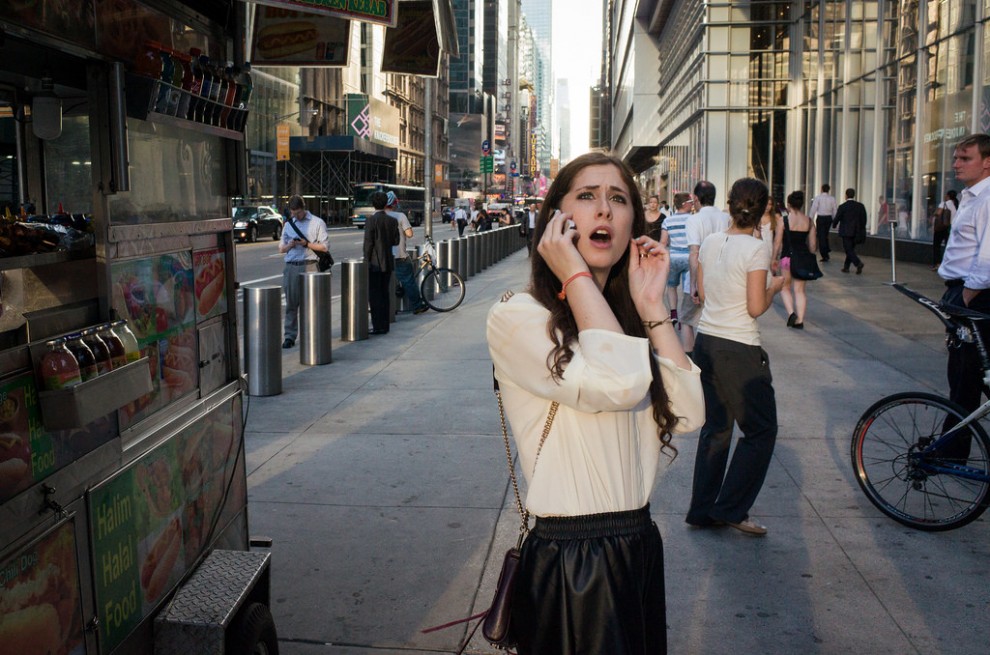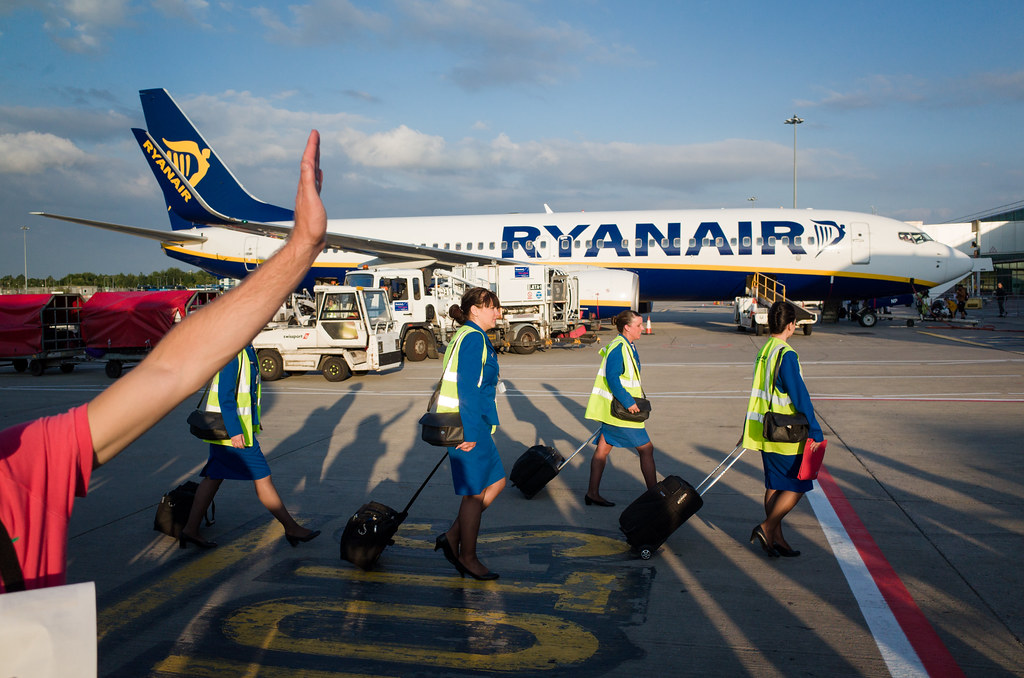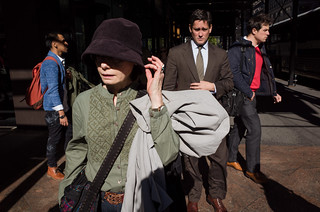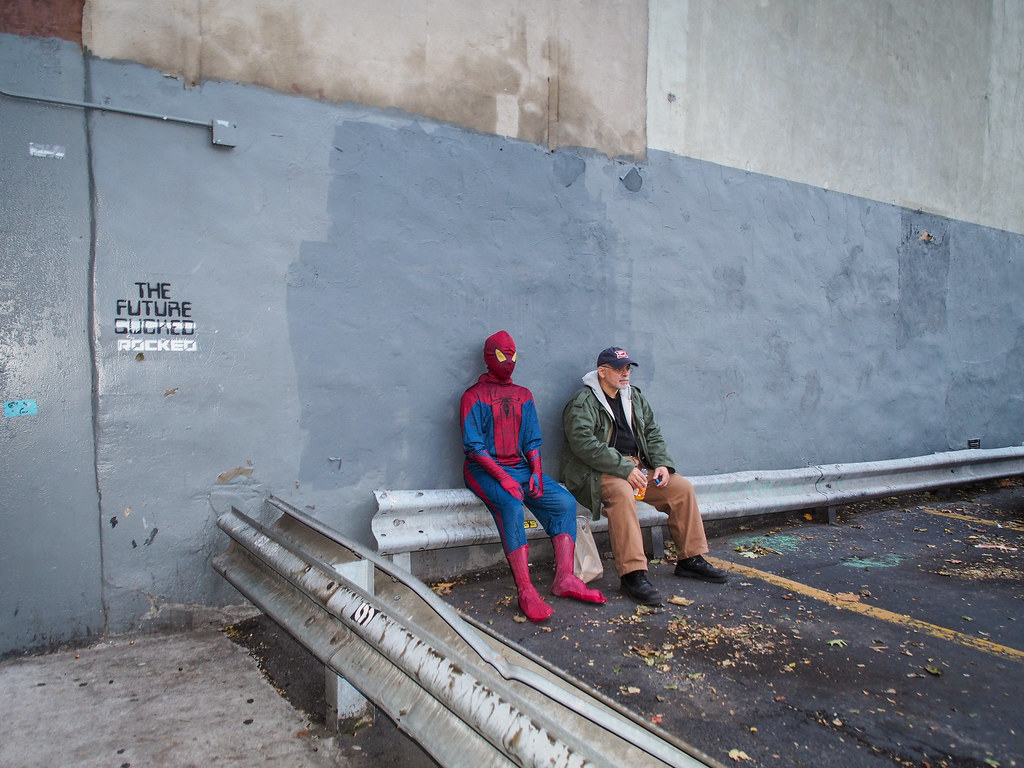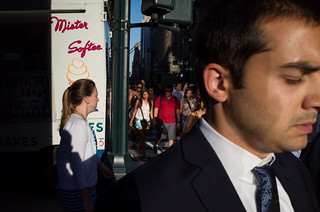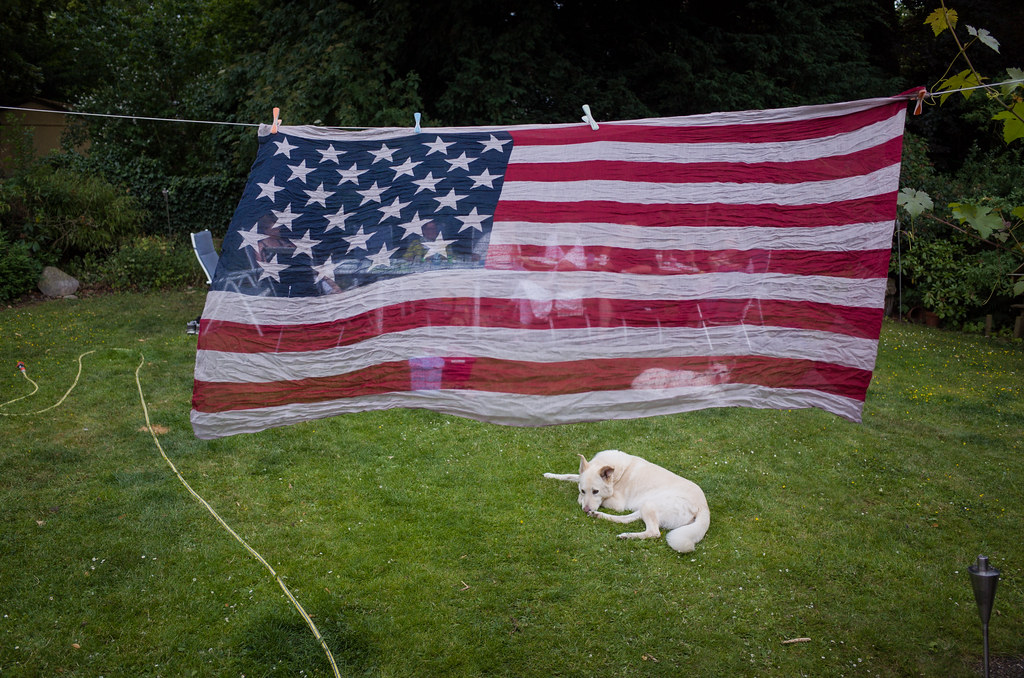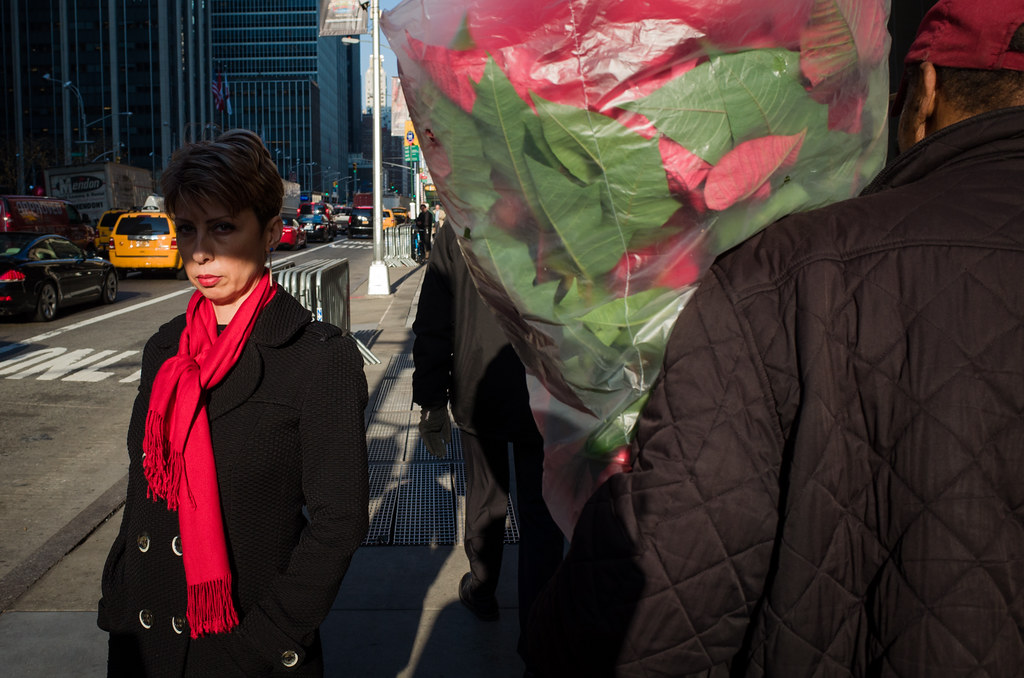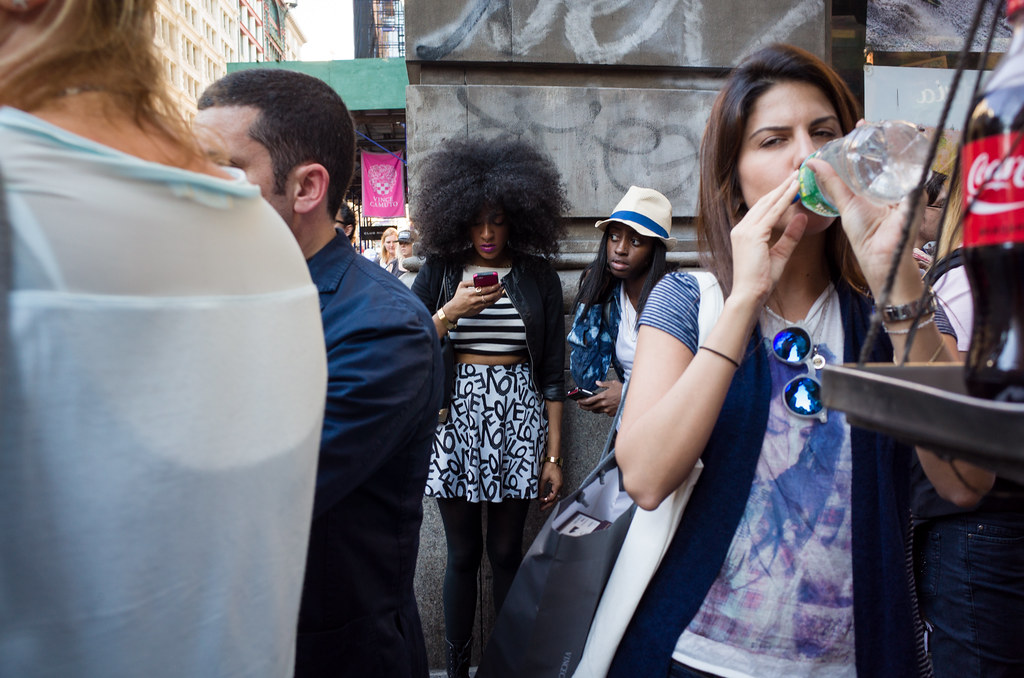Chris Farling is a founding member of the Observe Collective and his perspective on street photography is informed by his experience as a jazz musician as well as the countless hours spent on the street. I had the pleasure to talk with Chris from his home in Brooklyn, New York and I found him to be a personable and well spoken advocate for our elusive art. Hit the jump for the full interview!
Chris Farling Interview: The Importance Of Critque And Improvisation In Street Photography
Chris Farling is working in the tradition of Winnogrand with candid frames that appear to have been caught in between seconds as life goes about living itself in real time. His perspective puts the viewer in middle of action on the street but there’s a softness to his captures; a gentleness that neither judges or characterizes.
The individual elements seem to float suspended while remaining very much alive. Giving you a moment to recognize them and understand them before you move along. Perfectly visualized glances that serve as both a record and a celebration of the city that created them.
But enough with the art speak and on to the Chris Farling interview:
StreetShootr: I like to start everyone off with an introduction. You know, in case someone has just landed on the planet Earth and has never heard of a Chris Farling/ Tell us who you are, what you’re all about? What makes you tick?
Chris Farling: Well, I’ve been living in Brooklyn for a while and I kind of love it here. I think the photography for me is part of something else. It’s not a complete overriding obsession to the exclusion of all other things for me. I find that one of the things that I like about photography is that it can go wherever you go and be part of the fabric of your life. And it can enhance the experiences that you’re already having. So I guess I’m curious about things.
One of the common threads for me and my personality is that I’m interested in improvisation – that’s what made me get into playing music. And that’s really the type of photography that I like. I appreciate a lot of different types of photography but in terms of seeing myself actually practicing them I couldn’t imagine doing studio photography or other things like that. Photography to me is all about wandering around, exploring, and taking pictures of things that interest me.
SS: The word improvisation implies that you’re making something up as you go, but improvisation in music isn’t just playing random notes, There’s structure and rules and practice that enable you to do it. How does that apply to street photography?
CF: I think part of what makes street photography interesting is that idea that anyone could turn around and see this thing happening. And there’s a sort of essential documentary truth to it but when someone blurs the lines too much it affects that truth. What comes naturally to me is to draw the line at not shooting explicitly posed things.
I think of street photography as something you react to the same way as improvisation. When you’re working with other musicians in real time and you have tools at your disposal. But the tools in a visual art are different. Rather than having your scales and command of your horn or piano you’re talking about being able to easily switch settings or whatever you need to do on the camera. So you can just be there without a technical barrier between you and what’s happening.
And also there’s the visual literacy of knowing what this image is trying to be and being able to bring out what’s special about a scene by lining things up in the frame in a certain way. You have sort of visual templates from great photography that you’ve looked at in books or on the walls of a gallery or whatever.
SS: How did you first discover photography?
CF: I dabbled a little bit in film photography in high school. And I liked the idea and the way it felt to walk around with a roll of film and load it up and see what you could find out. So in some sense the idea of walking around and being surprised by what you see then trying to make a photograph out of it has been with me for a long time.
When digitial cameras came out I got into that pretty early but I didn’t really consider that a digital camera could have the magic of a film camera. And it wasn’t until maybe 5 years ago that I got a decent digital camera that was beyond a point and shoot. It was an Olympus Micro 4/3, one of the first ones that came out. And when I got that I realized right away that I could take nice solid photographs with this device.
Of course, now I think I could go back to a point and shoot and get whatever results I want. But at the time it didn’t inspire any thought of making interesting photographs. I was just taking the usual vacation shots that everyone takes.
SS: So how did that lead you to street photography?
CF: I think I started shooting little details in the city. Like a piece of trash on the street or a stuffed animal bear stuck in a fence! It’s not interesting now but I really didn’t understand that street photography was a thing that I could do. I had seen Robert Frank’s exhibit many years ago and I was blown away. But I felt like that was just something that a major artist can do.
I broke down that barrier by just looking at a lot of different photographs. I’d see shots on Flickr where photographers were just walking up to people and taking their picture. And I remember thinking, “What is this?!” And I’d see comments on their pictures where other people were thrashing the shot and that was pretty intimidating but I eventually got into that seen and saw what it was like.
I was just starting to shoot street myself and when I was taking those first baby steps it was good to have that critical aspect informing me. At a certain point you may leave the keep/ditch sensibility that’s popular on Flickr. But it’s still important to maintain that critical edge when you’re looking at your own stuff.
SS: You’ve been instrumental in a couple of prominent Flickr groups like Street Crit and Street Fight. Two groups with a heavy focus on critque. Can you talk about that a little bit?
CF: With Street Crit, I really just inherited a splinter group from Grit And Grain. It had its own built in community and we were just trying to keep its ethos going. But Street Crit had no barrier to entry and anyone could submit a photo as long as they commented on everybody else’s photos. So people tend to just run through and give poor critique.
The thing that’s good about Street Fight is that the photo match-ups are curated. We get a lot of great photos in the queue and we choose ones that are really worth looking at. And while not everyone will love every shot that week there’s at least some standard where all the pictures are worth taking the time to critique.
And I think taking the time to unpack and analyze someone else’s picture is the most valuable thing you can do. Because eventually you’re going to start bringing that language and that visual literacy to your own images. And it’s sort of a mutual thing. It’s like they’re kind of softening you up by critiquing your photos. And you kind of get used to how it feels to have faults found in your own work. At the same time you’re seeing other people’s work and you get such a variety of images that it maybe opens up new directions for your own photography. And you start to be able to enunciate why you’re interested or not interested in different kinds of images. That’s important.
SS: I always say if you put three photographers in a room, two will wait for one to leave so they can talk shit about his work! A lot of critique feels derogatory more than helpful. How do you sort the bullshit from really good critique?
CF: I guess you have to look through a lens and wonder if this person might have an agenda when they’re saying what they’re saying. But there still may be something of truth in their critique. And there may be times when some message that’s actually valuable gets lost in the vitriol and you’re not ready to hear it. And that message might stay in your mind because it’s upsetting or something. You never know.
And then other times it’s maybe a more measured critique that resonates with you. It tends to be when people really take the time to look at what they’re seeing and critique it should be valuable to hear about it even if you don’t agree with what’s being said. But you have to hold onto your own ideas. The whole point of critique isn’t just to have other people tell you what’s good becuase then you’ll just do what other people want. It’s about shaping your own vision.
SS: So it’s a matter of not believing that the critique is an assessment of the quality of the work. But simply sucking it up when people don’t like your work and making your own mind up later?
CF: That and filtering out the noise. If you really believe a certain thing is core to what you’re trying to do then don’t listen to people when they tell you not to do that. Try it and follow through on it and see where it takes you but if you’re not so sure then you should be letting in more opinions. But it’s always a dance between just hearing other people’s voices and starting to make some of those judgements yourself and come up with your own style and your own way of seeing.
SS: What advice do you have for any street photographer for giving critique to other people? If you’re saying the best way to get better at your own photography is to critique other people’s work is there a process that you go through? Or do you just basically just let it go?
CF: I’d say just spend the time and really commit to doing it. And at the same time holding onto maybe that first impression you have when looking at an image. Sometimes people get tripped up on thinking good critique is long. Or that it has to talk about every position of every thing in the frame. But that sometimes misses the bigger picture. What is the overall feel? What’s your first impression? What’s the impact? And then also how did they get to that? Does what’s in the frame contribute to that? How does the image work? Basically you’re trying to figure out how this photograph was put together.
I remember taking a music workshop and the instructor basically said the days of just listening to your favorite musicians is over. If you want to be professional you need to listen and be thinking about how that song works. How did he do that? And it becomes very clinical at that point. Sometimes people are afraid that it will take the magic away from the overall photograph to think like that. But at some point being able to look at the little parts and think about how someone made a picture is useful.
SS: Since we’re talking about critique, I have to mention your Tumblr blog where you self-critique images that you took 36 months ago. What’s the motivation?
CF: I think it’s useful to kind of keep circling back. Because there are some things that maybe you like more than you did at the time. And there’s others that you like less or they don’t seem special anymore because you’ve seen the same thing repeatedly since then.
One of the difficulties in critiquing other people’s shots is that you generally don’t want to get into, “Oh ya you should have taken a step to the left and then this would have…” Because you weren’t there. But here I can usually remember exactly what the scene looked like and actually think maybe how I could have taken that step to the left. And it’s surprising how vivid some of the memories of shooting are.
One of the things I was hoping to do was to remove that sense of it. To actually be able to finally look at the pictures as artifacts and not as experiences. And yet the experiences are still there and so it’s hard to not comment on that or bring that in. So I guess I’ve kind of given up on that purity of approach. And when I remember the experience often I’m bringing that into it as well.
SS: You’re a founding member of Observe. How did the collective come together?
CF: It actually came out of a private Flickr group. It was actually kind of a proto Street Fight in the sense that it you go head to head each week against somebody. Every week your photo had to be taken within the previous two weeks. So over the course of 9, 10 11 weeks you really just have to be shooting all the time or you’re just not going to have anything to show.
So we enjoyed that format and a lot of the people in the group ended up becoming Observe. And honestly we kind of enjoyed each other’s photography and enjoyed the critique that we were getting from each other. And the totally non-photography related banter that we would have. At one point Danielle Houghton suggested we start a photography collective. Of course I was super nervous.
I may be the least ambitious street photographer there is. I want to work on being better but the whole promotion side is difficult for me to get excited about. So one of the things that’s cool about being in a collective is that it sort of offloads some of that responsibility of promoting yourself. You can just promote the group. And that feels more natural to me.
SS: A lot of photographers would jump at the chance to be in a collective while others scoff at the idea. Why do you think that is? Why do you think collectives can be so controversal?
CF: To some degree it’s absurd to worry about what group you’re in when street photography is a solitary endeavour. Ultimately you have to find your path. You have to evaluate your own shots. There’s no real pressing need to be in a collective. That said, it’s comforting in a way. I know that there are people that I can easily ask their opinion on my shots. And there’s something about regularly organizing things that keep you feeling connected with other people. So it’s good that way. We all get along very well and a lot of different people but we just, you know, the personalities are such that we amuse each other. It’s still fun.
There are definitely different ideas about what a collective should be. For some people it’s strictly something for their resume. And then others it’s more about the fit, personality wise. I guess it’s maybe with so many collectives it’s maybe a bit overdone in the sense that a random shooter shouldn’t feel they have to get in a collective because this or that photographer is in a collective. Nobody really cares.
One of the things I like about Observe is that we are really into including the street photography community in things we do. So while we run things like the Street Fight Flickr group we don’t feature out own photography. It’s about what other people are doing. So I value that connection just as much as I value being in a private collective. It’s just another organized way of being involved in what everyone’s doing.
SS: What would you consider to be your favorite picture that you’ve personally taken. I know these things often change over time…
CF: I guess maybe I have one called Khakistan that’s kind of different people arranged on a corner. None of them are related to each other but they’re all randomly wearing these khaki jackets and shirts and whatever. And I guess what I like about it is that it’s sort of a heightened moment but only when you put a frame around it that it becomes something more. It’s just one of those things where you see it an think, “How could all these random people come together like that on a random corner?”
At the time I was finally starting to slow down and work the scene a little more. I took a bunch of shots at that point. The final shot wasn’t the first one I took, it wasn’t the last one. It was somewhere in the middle and maybe I wouldn’t have gotten that shot a month earlier. So I guess I like it for those two reasons. One, it’s a great moment but also it’s a marker or a milestone in my own development as a street photographer.
SS: When you shot this shot did the “khakiness” register? Was that what you were shooting or was it just the interest of the grouping of the people themselves?
CF: Oh definitely that was one where the meaning was really apparent to me and definitely what I was trying to capture. But I was also working on clarity and cutting out of all non-essential things. Because I shoot with a wide angle lens in busy places I tend to have a lot of extra stuff in the frame that’s not necessarily integral to the subject. In this case I knew what I was looking for and I was able to make it into a shot that I liked. It just kind of worked for me. And that’s something that a continual struggle for me. Picking what’s essential and getting rid of everything else in the frame.
SS: I’ve heard you say that you’re near misses are often more interesting than their polished counterparts. As someone who’s entire photographic body of work is made up of near misses, I took this to heart! [Laughs] What’s so interesting about your misses?
CF: I guess what I was saying there was that street photography sometimes works best when there’s a little messiness about it. When the edges are suggesting life outside the frame and it’s not just a nice little box. It’s just easy to say this is bad or that is bad and it should all be taken out. And to always try and control things maybe too much instead of letting the scene be what it is. If that’s a little messier then sometimes that can be a good thing.
SS: Do you have any final advice for our readers? Something that you wish you had known at some point along your journey that would have made life as a street photographer a little easier?
CF: The simplest advice is just to keep shooting. And keep re-evaluating. Shoot, then look. Assess where you’re at then shoot some more. Ultimately you have to go out and actually do it. And you find yourself over time that you take fewer pictures because you’re going over the same neighborhoods and seeing the same things. And maybe in your mind you’ve already taken that shot so you don’t take it again. But being open to what’s around you is important. Don’t just go out and collect photos but take the time to see things with as much wonder and as much interest as you can bring to it. All the stuff that the normal people tune out when they walk down the same street and they’re on their phone or whatever. You need to be the opposite of that person. You want to be the one who’s seeing what’s going on around you.
SS: Chris, this has been amazing. Thanks for taking the time to talk to us today!
CF: My pleasure!
Chris Farling On Observe.
Chirs Farling On Flickr.
36 Months Ago I Made These Pictures.
Street Crit Flickr Group.
Grit And Grain Flickr Group.
Street Fight Flickr Group.
All images © Chris Farling.
What’s your take on StreetShootr’s Chris Farling interview? How does the idea of improvisation apply to your own street phtoography? Post your ideas in the comments below and keep the conversation going!

